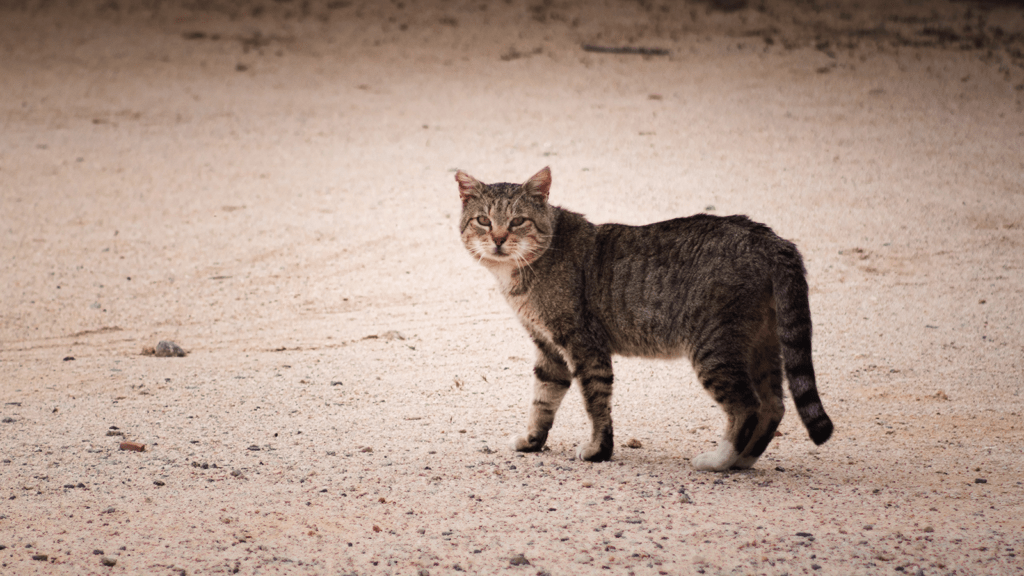
Feral Cat Facts
Feral cats are stray cats who were never socialized to humans. Populations can quickly get out of hand because a single female cat can birth about 24 kittens each year—and those kittens will go on to have kittens of their own. TNR (or trap, neuter, return) is the best way to help feral cats.
In this article, we’ll talk about the problems feral cats face and how you can help the cats in your community.
Problems feral cats face
Cats allowed outdoors live shorter lifespans than indoor-only cats. This is especially true of feral cats who don’t receive help from a human caretaker. These cats have a life expectancy of just 2-5 years.
Many problems contribute to this, but the most common causes of death in outdoor cats are disease and cat fights (source).
Below are some common problems feral cats face and how you can help!
Overpopulation
Overpopulation is bad for cats, humans, and the environment. Outdoor cats have led to countless animal extinctions. Fights can occur when there are too many cats and not enough resources.
Many consider stray cats a nuisance, but it’s humans who introduced them to the local environment! It’s our responsibility to manage their populations and, when we can, get them off the streets.
The most efficient and humane way of doing this is with TNR or Trap, Neuter, Return. First, use a humane live trap to catch the cat. Then, have them neutered or spayed by a local veterinarian. Lastly, return them to their territory.
A colony caretaker can then monitor the cats, providing them with assistance to live healthier, happier, and longer lives.
Disease
Diseases like Feline Immunodeficiency Virus (FIV) and Feline Leukemia Virus (FeLV) are contagious and deadly. They can take out entire colonies of cats.
If you’re caring for a colony, consider getting them vaccinated yearly. This will reduce, not eliminate, their chances of catching FIV or FeLV.
Parasites
Fleas and ear mites are very common in outdoor cats. They may also be bitten by ticks or develop heartworm after a mosquito bite.
All of these parasites are preventable using parasite prevention medications. Speak with a veterinarian in your area to see what the cats are most at risk for.
A veterinarian can also advise you on the best plan for keeping a feral colony treated. For instance, they may suggest a yearly heartworm vaccine rather than monthly medication if the cats are feral.
Catfights
Not only can cats kill one another, but they can also spread disease through fighting or cause wounds that become infected. Cat bites and scratches become infected so commonly that there’s a name for it—cat scratch fever.
Cats fight less when they have ample resources. Feeding a colony can help to prevent infighting.
TNR can also help to reduce the population, thus allowing the existing cats more resources. Intact cats tend to be more territorial as well, especially males who will fight for a female’s attention.
Predators
Predators of cats include:
- Coyotes
- Cougars
- Wolves
- Birds of prey
- Snakes
- Dogs
Humans
As we discussed above, some people view stray cats as a nuisance. These people may go so far as to leave out poison to kill them.
Killing feral cats is illegal, but unfortunately, it is all too common.
Traffic and automobiles
Lastly, cats don’t know not to wander into the street. Their chances of being hit by oncoming traffic increase if they’re near main roads, but even on a less-traveled road, there’s still a chance.
What should I do with a stray cat?
Is it feral or tame?
If you find a stray cat, first determine if it is feral or tame.
Tame cats may let you approach (though not always). They’ve been socialized to humans and thus trust us more than feral cats.
I’ve also had experience with tame cats meowing at me repetitively like a cry. Once, my own housecat escaped home by tearing through a window screen, then proceeded to hide behind the garage, crying for me but not letting me close enough to retrieve him!
A neighbor’s cat once yelled in the same way after running across the yard, too nervous to come to me but still apparently wanting to talk.
Feral cats don’t really interact with humans in this way. They’ll be very flighty, won’t let you come near, and may hiss or resort to violence if backed into a corner. Because they’re unsocialized, feral cats are incredibly afraid of people.
In a live trap, feral cats are also less likely to stay calm than strays.
Tame cats can be rehomed
Try contacting your local rescue or even bringing the cat into your own home if you’d like! Tame cats may complain about being kept indoors at first, but they do well after an adjustment period.
If you cannot find a rescue to help and cannot foster the cat yourself, the best thing to do is to leave the cat outdoors. Shelters are overrun with cats, and euthanasia rates are high—you don’t want to do more harm than good!
TNR can help all strays—especially ferals
TNR is the best thing to do for feral cats or tame strays who must stay outdoors. It lengthens their lifespan, reduces some behavioral issues like catfighting, and controls the population so it doesn’t get out of hand.
If you’re struggling to TNR your local cats, contact a rescue or local organization that specializes in TNR. Also, look into low-cost spay and neuter programs.
Monitoring the cats after TNR is also crucial to the feral cats’ well-being. Consider becoming a caretaker who feeds your local colony and brings them to the veterinarian as needed. (Check with your veterinarian for discounts or contact rescue organizations to see if they’ll help with funding!)
Feral cats can also be brought indoors if you’d like, though it will be stressful for them. Most rescues won’t accept feral cats due to their abundance and the resources it takes to rehabilitate them.
Help—there are too many strays!
Has your neighborhood gone from a few stray cats here and there to cats everywhere you look? This is super common!
Some people begin caring for a couple of stray cats only to become a caretaker for way more cats than they can handle.
This is why TNR is so vital to control populations. But if you’re already overrun, consider the following:
- Capture mama cats and litters. They can be fostered until the kittens are weaned. Then, mama cat can be spayed and returned to her outdoor territory. The kittens can be adopted out to loving homes.
- Rehome tame strays. If any cats in the colony are human-friendly, try finding new homes for them via neighbors, friends, family, or rescue groups. (We don’t recommend bringing them to a shelter due to a high risk for euthanasia.)
- Begin TNR as soon as possible. It really is the only way to keep the population under control.
Where do feral cats sleep?
Cats can sleep up to 20 hours a day. They feel most secure when they can hide, and they’re willing to get creative to find a napping spot!
Cats and kittens might choose abandoned buildings, sheds, garages, or beneath trees and shrubs. They might also choose high places to hide, as they like the ability to view their surroundings. You may see feral cats sleeping on rooftops or in trees.
How far do feral cats roam?
Despite their sleeping patterns, feral cats can roam a territory of more than 1300 acres (source). Unneutered males roam the furthest, while females tend to have smaller territories.
Feral cats mark their territories and their fellow colony members via scent. You’ll notice them rubbing their bodies, tails, and cheeks against each other or solid objects. They may scratch tree trunks, leaving pheromones with the glands in their paws, or spray urine.
These markings let other cats know where they’ve been, how long ago they were there, and when they will return. This reduces fights as other cats will leave the territory, preferring to avoid confrontation.
What do feral cats eat?
Feral cats prefer small rodents like mice but will also eat larger rodents, birds, bats, and human trash. Of course, feral cats can also be fed cat food!



